|
|
|
Sort Order |
|
|
|
Items / Page
|
|
|
|
|
|
|
| Srl | Item |
| 1 |
ID:
182744
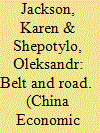

|
|
|
|
|
| Summary/Abstract |
This paper explores the impact of the Belt and Road Initiative (BRI), in terms of changes in trade costs on trade and consumer welfare in China, the EU, and the rest of the World. We employ a general equilibrium structural gravity approach and conduct a counterfactual analysis. Our key findings are as follows: (i) China and the EU are expected to make substantial gains from the BRI due to reductions in transport costs; (ii) signing and implementing a deep FTA between China and the EU is equivalent to transport cost reductions of 15–20%; (iii) the joint policy of the BRI and FTA is super-additive, magnifying the gains from the separate policies; and (iv) where transport cost reductions are 20% or more, the potential negative effect of the China-US trade war on China is more than compensated for by the BRI initiative. Our results provide evidence that the BRI has the potential to deliver significant welfare gains, particularly if combined with other trade integration schemes, and to counterbalance aggressive trade policies.
|
|
|
|
|
|
|
|
|
|
|
|
|
|
|
|
| 2 |
ID:
182743


|
|
|
| 3 |
ID:
182749


|
|
|
|
|
| Summary/Abstract |
The deferred acceptance mechanism (DA) replaced the Boston mechanism (BM) in college admissions in China. In this paper, I compare the empirical performance of these two mechanisms in the Chinese context by developing an empirical model and applying it to college admissions in Guangxi, Hebei, and Sichuan provinces. Then, I conduct counterfactuals to empirically compare the BM and DA in these three provinces for given years. I find that not only is the BM superior to the DA in terms of total welfare but also that most students receive lower utility after the switch from the BM to DA.
|
|
|
|
|
|
|
|
|
|
|
|
|
|
|
|
| 4 |
ID:
182747


|
|
|
|
|
| Summary/Abstract |
Financial constraint is a significant obstacle for firm growth, especially in developing countries where credit is scarce. This paper explores the role of tax policy in relaxing firms' financial constraints by exploiting China's value-added tax (VAT) reform that was initiated in 2004 and completed in 2009. We use a quasi-experimental method and Annual Survey of Industrial Firms (ASIF) data from 2000 to 2009 to estimate the VAT reform's policy effects on financial constraints. We show that the VAT reform significantly improves firms' external financing capacity by decreasing borrowing costs and promoting commercial credit. The findings are robust to alternative specifications but show heterogeneity across ownerships, firm sizes, regions, and between export and non-export firms. Our analysis suggests tax deduction is useful to relax firms' financial constraints.
|
|
|
|
|
|
|
|
|
|
|
|
|
|
|
|
| 5 |
ID:
182752
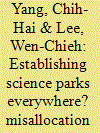

|
|
|
|
|
| Summary/Abstract |
The establishment of science parks is a vital strategy to develop high-tech industries and facilitate innovations in China. The success of a science park depends heavily on its supportive environment, suggesting that it is hard to replicate everywhere, while China has established many science parks across regions in the past decade. This study evaluates the degree of misallocation in research and development (R&D) and its determinants across science parks in China. Based on an unbalanced panel data of 145 science parks for the period 2007–2014, we find that the overall R&D efficiency has decreased sharply since 2011 when China began to initiate many new science parks. The newly constructed science parks exhibit a lower R&D efficiency than their incumbent parks, suggesting a considerable misallocation in R&D resource caused by expanding science parks everywhere. We further investigate the determinants of R&D misallocation and find that park characteristics and environmental characteristics matter. Parks which are larger, older, and having a higher human quality experience a lower R&D misallocation. Parks with closer R&D collaboration with universities or research institutes, particularly with universities, exhibit a lower R&D misallocation.
|
|
|
|
|
|
|
|
|
|
|
|
|
|
|
|
| 6 |
ID:
182748
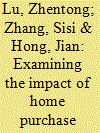

|
|
|
|
|
| Summary/Abstract |
This paper studies the impact of home purchase restrictions on China's housing market. We estimate a structural model of household preference for housing, real estate developers' pricing decisions, and equilibrium market outcome in five large cities. By comparing the estimation results from pre- and post-policy intervention, we find that, after home purchase restrictions are implemented, overall housing demand in most cities becomes weaker and less price elastic; meanwhile, real estate developers face higher holding costs and thus are willing to lower prices and sell more quickly. Counterfactual analyses show that in some cities alternative policy designs that cause less structural change of demand could achieve larger consumer welfare and social welfare than the implemented policy.
|
|
|
|
|
|
|
|
|
|
|
|
|
|
|
|
| 7 |
ID:
182755


|
|
|
|
|
| Summary/Abstract |
Broke out at the end of 2019, the novel coronavirus pneumonia (COVID-19) has been spreading throughout the world, leading to more than 87 million confirmed infections and 1.88 million fatalities. Motivated by this, we evaluate the economic impacts of COVID-19 outbreak on both national and industrial levels by employing quarterly computable general equilibrium (CGE) model. Our results reveal that the epidemic may lower China's economic growth in 2020 by 3.5%, versus 4.4% for final consumption (relative to baseline). The service industry suffers the most from the outbreak, and the Accommodation-Food-Beverage service, Wholesale-Retail Trade, and Transport-Storage-Post are identified as the most vulnerable sectors, with the negative impact on output reaching as high as 14.6%. When moving to 2021, the hit to economy shrinks to 2% (1.2–2.7%), with industry estimated to be the most affected sector instead. This study indicates that implementing effective measures for preventing and controlling the epidemic and policies for post-disease economic recovery play critical role in curbing the potential economic damage.
|
|
|
|
|
|
|
|
|
|
|
|
|
|
|
|
| 8 |
ID:
182754
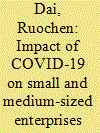

|
|
|
|
|
| Summary/Abstract |
This paper examines the short-term and mid-term impact of COVID-19 restrictions on SMEs, based on two waves of phone interviews with a previously surveyed large SME sample in China. The outbreak of COVID-19 and the resultant lockdowns took a heavy toll on SMEs. Afflicted by problems of logistics blocks, labor shortages, and drops in demand, 80% of SMEs were temporarily closed at the time of the first wave of interviews in February 2020. After reining in COVID-19, authorities largely eased lockdown restrictions in April. Consequently, most SMEs had reopened by the time of the second round of surveys in May. However, many firms, particularly export firms, were running at partial capacity, primarily due to inadequate demand. Moreover, around 19% of incorporated enterprises and 25% of self-employed businesses had permanently closed between the two waves of surveys.
|
|
|
|
|
|
|
|
|
|
|
|
|
|
|
|
| 9 |
ID:
182756


|
|
|
|
|
| Summary/Abstract |
Infectious diseases put health of millions at risk and induce large socioeconomic costs each year. However, the long-term effects of exposure to infectious diseases on the elderly have received minimal attention. Using data from the Chinese Longitudinal Healthy Longevity Survey, this study adopts a differences-in-differences strategy to evaluate the long-term effects of epidemic exposure on old-age mortality. We find that intense exposure to the severe acute respiratory syndrome (SARS) epidemic led to an increase in old-age mortality after the SARS outbreak. We provide some suggestive evidence that exposure to SARS increased psychological stress and limitations in physical activities among old people.
|
|
|
|
|
|
|
|
|
|
|
|
|
|
|
|
| 10 |
ID:
182746
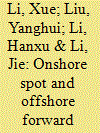

|
|
|
|
|
| Summary/Abstract |
This paper investigates the dynamic relationship between the onshore spot market and offshore forward market for Chinese currency around the period of China's “8.11” exchange rate regime reform, one of the most important market-oriented reforms implemented on August 11, 2015. We compare return and volatility spillover effects between the two markets before and after the “8.11” reform. The empirical evidence shows that a remarkable change has occurred in both the return and volatility spillovers. Before the reform, return and volatility spillovers exist from the offshore forward market to the onshore spot market. After the reform, however, we observe an obvious reverse in the direction and an increase in the strength of the return and volatility spillover effects. These findings suggest the existence of cross-market information flows, a change in the direction and a strengthening of the dynamic relationship after the reform. We argue that the “8.11” reform serves as a milestone reflecting long-term underlying forces that increase the relative importance of the onshore market.
|
|
|
|
|
|
|
|
|
|
|
|
|
|
|
|
| 11 |
ID:
182751


|
|
|
|
|
| Summary/Abstract |
Resource-rich locations often rely on exporting the resources to prosper, but resource depletion is a matter of time. An industrial transformation is necessary to sustain economic growth when the comparative advantage fades away. This paper concerns the Resource-Exhausted City Transition program, a large-scale place-based policy of the Chinese state government. It applies firm data and examines impacts on industrial development in places suffering from resource-exhaustion. Estimation shows that the program has stimulated capital investment largely and fostered employment and efficiency as well, leading to a boost in output. The program does not favor the resource sector with little comparative advantage. It facilitates an industrial upgrade by extending the value chain towards the downstream and stimulating higher value-add activities. Effects are heterogeneous among firms with different capital intensity, age, size, ownership type, or regions.
|
|
|
|
|
|
|
|
|
|
|
|
|
|
|
|
| 12 |
ID:
182750


|
|
|
|
|
| Summary/Abstract |
Structural transformation is a key feature of economic development. Traditional literature attributes it to changes in the sectoral composition of consumption. Different from it, we argue that “servicification” of investment goods, induced by investment-composition technological change, becomes an increasingly important reason for structural transformation, particularly for the rise of the services economy. Our study of the input output tables finds that the share of service inputs in investment goods has grown significantly in many countries since the 1980s, especially for investment-intensive economies such as China. To assess if the investment channel is quantitatively significant, we build a standard model with three broad sectors, but instead add an investment production function employing factors from all three sectors. Moreover, we incorporate investment-composition technological change by allowing the productivities of the three sectoral inputs to evolve over time. We calibrate the model to the Chinese economy from 1981 to 2014 and perform counter-factual experiments accordingly. We find that investment-composition technological change accounts for 33.1% decline in employment share of agriculture, 36.0% increase in employment share of manufacturing and 31.5% increase in employment share of services over the period. The magnitude of this effect on the share of services keeps growing, particularly after 2000. Our findings are not unique for China, but also apply to other economies experiencing the “servicification” of investment.
|
|
|
|
|
|
|
|
|
|
|
|
|
|
|
|
| 13 |
ID:
182753
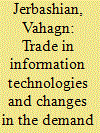

|
|
|
|
|
| Summary/Abstract |
I use data from the World Input-Output Database and show that trade in information technologies (IT) has a significant contribution to the growth in foreign intermediate goods in the 2001–2014 period. China has strongly contributed to the rise in trade in IT and has become one of the major foreign suppliers of IT. I merge these data with the EU KLEMS database and EU Labour Force Survey and obtain a dataset of 12 European countries and 2001–2007 period. I show that IT imports from China are associated with lower IT prices in European countries. The fall in IT prices has increased the demand for high wage occupations and reduced the demand for medium wage occupations. Nearly 25% of the variation in the demand for occupations can be attributed to the trade with China.
|
|
|
|
|
|
|
|
|
|
|
|
|
|
|
|
| 14 |
ID:
182745
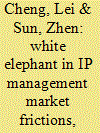

|
|
|
|
|
| Summary/Abstract |
This paper examines the maintenance decisions for intellectual property (IP) that require continuous investment in an uncertain market environment. We propose a microfoundation-based theory that incorporates market friction, market connection and escalation of commitment from the managers. In a dynamic market with frictions, managers with weak market connection need longer time to reach successful transactions, compared to the strongly connected ones. Moreover, escalating behavior could make it harder for the less connected managers to abandon their IP assets even when the embedded value becomes obsolete, which leads to inefficiently longer maintenance and an unforeseen social loss. The model further suggests that removing frictions in the market facilitates transactions and reduces the performance gap between different managers. We provide empirical evidence that is consistent with the theory, using data on patents from individual innovators with different levels of market connection. The study contributes to the discussion on organizational implications of escalation of commitment, and also shed light on the importance of market connection to value capture of small innovative businesses.
|
|
|
|
|
|
|
|
|
|
|
|
|
|
|
|
| 15 |
ID:
182757
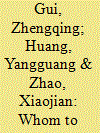

|
|
|
|
|
| Summary/Abstract |
We conducted an experiment and survey in Shenzhen, China, to measure individuals' risk preferences, financial literacy, and the effect of a financial education program. A proportion of individuals may be unaware of the high risk associated with a high-return financial product and thus may purchase financial products inconsistent with their risk attitudes. Participating in our education program significantly reduced individuals' tendency to hypothetically invest in high-risk products, especially for those who are risk-averse. Therefore, rather than randomly assigning the education program to investors, we suggest that risk-averse investors be targeted. We find that the responses to standard financial literacy questions are not related to individuals' awareness of the link between high risk and high return, calling for a newly designed question of financial literacy as proposed in our study.
|
|
|
|
|
|
|
|
|
|
|
|
|
|
|
|
|
|
|
|
|